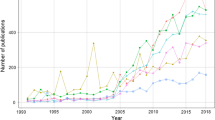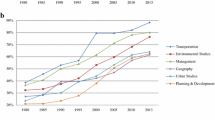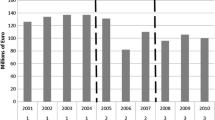Abstract
Using different methods to assign disciplines to publications can influence bibliometric analyses. In this study, we test the influence of applying two different types of classification on the disciplinary collaboration rates of researchers from the Social Sciences and Humanities. Two different classification types are contrasted: organisational classification, which assigns discipline(s) based on the discipline of the unit(s) of the authors, and cognitive classification, which considers the discipline(s) assigned to the channel of the publication. The data set is based on a comprehensive local database of SSH research in Flanders, Belgium. Applied to collaboration, the two classification types both show an overall increase in co-authorship in SSH during the studied period. For certain periods, however, they reveal clearly dissimilar trends, especially for publications written by Humanities scholars: while the Humanities according to the cognitive classification have reached a plateau in co-authorship, collaboration rates in the Humanities according to the organisational classification continue to increase. We show that these variations are due to an increase in the proportion of publications of Humanities researchers outside Humanities channels. As such, the comparison of classification types can provide a deeper understanding of disciplinary differences in the evolution of co-authorship.




Similar content being viewed by others
Notes
VABB-SHW stands for “Vlaams Academisc Bibliografisch Bestand voor de Sociale en Humane Wetenschappen” (Flemish Academic Bibliographic Database for the Social Sciences and Humanities). See https://www.ecoom.be/en/data-collections/vabb-shw for more information.
References
Abramo, G., D’Angelo, A. C., & Murgia, G. (2017). The relationship among research productivity, research collaboration, and their determinants. Journal of Informetrics, 11(4), 1016–1030. https://doi.org/10.1016/j.joi.2017.09.007
Abramo, G., D’Angelo, C. A., & Di Costa, F. (2009). Research collaboration and productivity: Is there correlation? Higher Education, 57(2), 155–171. https://doi.org/10.1007/s10734-008-9139-z
Birnholtz, J. P. (2006). What does it mean to be an author? The intersection of credit, contribution, and collaboration in science. Journal of the American Society for Information Science and Technology, 57(13), 1758–1770. https://doi.org/10.1002/asi.20380
Bonaccorsi, A. (2022). An epistemic approach to research assessment in the social sciences. In T. C. E. Engels & E. Kulczycki (Eds.), Handbook on research assessment in the social sciences (pp. 14–47). Edward Elgar Publishing.
Daraio, C., & Glänzel, W. (2016). Grand challenges in data integration—state of the art and future perspectives: An introduction. Scientometrics, 108(1), 391–400. https://doi.org/10.1007/s11192-016-1914-5
deB Beaver, D. (2004). Does collaborative research have greater epistemic authority? Scientometrics, 60(3), 399–408. https://doi.org/10.1023/B:SCIE.0000034382.85360.cd
Engels, T. C. E., & Guns, R. (2018). The flemish performance-based research funding system: A unique variant of the Norwegian model. Journal of Data and Information Science, 3(4), 45–60. https://doi.org/10.2478/jdis-2018-0020
Guns, R., Sīle, L., Eykens, J., Verleysen, F. T., & Engels, T. C. E. (2018). A comparison of cognitive and organizational classification of publications in the social sciences and humanities. Scientometrics, 116(2), 1093–1111. https://doi.org/10.1007/s11192-018-2775-x
Henriksen, D. (2016). The rise in co-authorship in the social sciences (1980–2013). Scientometrics, 107(2), 455–476. https://doi.org/10.1007/s11192-016-1849-x
Henriksen, D. (2018). What factors are associated with increasing co-authorship in the social sciences? A case study of Danish economics and political science. Scientometrics, 114(3), 1395–1421. https://doi.org/10.1007/s11192-017-2635-0
Hsu, J., & Huang, D. (2011). Correlation between impact and collaboration. Scientometrics, 86(2), 317–324.
Katz, J., & Hicks, D. (2006). How much is a collaboration worth? A Calibrated Bibliometric Model. Scientometrics, 40(3), 541–554. https://doi.org/10.1007/bf02459299
Katz, J., & Martin, B. R. (1997). What is research collaboration? Research Policy, 26(1), 1–18. https://doi.org/10.1016/S0048-7333(96)00917-1
Kulczycki, E., Guns, R., Pölönen, J., Engels, T. C. E., Rozkosz, E. A., Zuccala, A. A., Bruun, K., Eskola, O., Starčič, A. I., Petr, M., & Sivertsen, G. (2020). Multilingual publishing in the social sciences and humanities: A seven-country European study. Journal of the Association for Information Science and Technology, 71(11), 1371–1385. https://doi.org/10.1002/asi.24336
Laudel, G. (2002). What do we measure by co-authorships? Research Evaluation - RES EVALUAT, 11, 3–15. https://doi.org/10.3152/147154402781776961
Lee, S., & Bozeman, B. (2005). The impact of research collaboration on scientific productivity. Social Studies of Science, 35(5), 673–702. https://doi.org/10.1177/0306312705052359
Lewis, J. M., Ross, S., & Holden, T. (2012). The how and why of academic collaboration: Disciplinary differences and policy implications. Higher Education, 64(5), 693–708. https://doi.org/10.1007/s10734-012-9521-8
Luwel, M. (2021). Performance-based institutional research funding in flanders, Belgium. Scholarly Assessment Reports. https://doi.org/10.29024/sar.29
Melin, G., & Persson, O. (1996). Studying research collaboration using co-authorships. Scientometrics, 36(3), 363–377. https://doi.org/10.1007/BF02129600
OECD. (2015). Frascati manual 2015. OECD Publishing. https://doi.org/10.1787/9789264239012-en
Ossenblok, T., Verleysen, F., & Engels, T. (2014). Coauthorship of journal articles and book chapters in the social sciences and humanities (2000–2010). Journal of the Association for Information Science and Technology. https://doi.org/10.1002/asi.23015
Piro, F. N., Aksnes, D. W., & Rørstad, K. (2013). A macro analysis of productivity differences across fields: Challenges in the measurement of scientific publishing. Journal of the American Society for Information Science and Technology, 64(2), 307–320. https://doi.org/10.1002/asi.22746
Ponomariov, B., & Boardman, C. (2016). What is co-authorship? Scientometrics, 109(3), 1939–1963. https://doi.org/10.1007/s11192-016-2127-7
Sivertsen, G., Deschacht, N., Aldberg, H., & Engels, T. C. E. (2013). The influence of performance-based university research funding systems on co-authorship practices. Translational Twists and Turns: Science as a Socio-Economic Endeavor. The 18th International Conference on Science and Technology Indicators, Berlin, Germany
Sugimoto, C. R., & Weingart, S. (2015). The kaleidoscope of disciplinarity. Journal of Documentation, 71(4), 775–794. https://doi.org/10.1108/JD-06-2014-0082
Verleysen, F. T., Ghesquière, P., & Engels, T. C. E. (2014). The objectives, design and selection process of the Flemish Academic Bibliographic Database for the Social Sciences and Humanities (VABB-SHW). In W. Blockmans, L. Engwall, & D. Weaire (Eds.), Bibliometrics use and abuse in the review of research performance (pp. 117–127). Portland Press.
Author information
Authors and Affiliations
Contributions
Conceptualization: CA, RG; Methodology: CA, RG; Formal analysis and investigation: CA; Writing—original draft preparation: CA; Writing—review and editing: CA, RG; Supervision: RG.
Corresponding author
Supplementary Information
Below is the link to the electronic supplementary material.
Rights and permissions
Springer Nature or its licensor (e.g. a society or other partner) holds exclusive rights to this article under a publishing agreement with the author(s) or other rightsholder(s); author self-archiving of the accepted manuscript version of this article is solely governed by the terms of such publishing agreement and applicable law.
About this article
Cite this article
Arhiliuc, C., Guns, R. Disciplinary collaboration rates in the social sciences and humanities: what is the influence of classification type?. Scientometrics 128, 3419–3436 (2023). https://doi.org/10.1007/s11192-023-04719-0
Received:
Accepted:
Published:
Issue Date:
DOI: https://doi.org/10.1007/s11192-023-04719-0




